
I will review this book in a few days. In the meantime, here is an interview with its author, Fraser McLean.
Didier Ghez: When did you decide to write this book and why?
Fraser McLean: The answer to the first part of the question is relatively short and sweet: the original idea for the book was hatched some time back in 2007.
The "why" part stretches back maybe 30 years or more - and perhaps needs a little more explaining......
A major part of the motivation for the project came from the fact that, in recent years, there has been a tremendous surge in the number of colleges and universities around the world that are offering courses in all aspects of animation - be it animation for movies, TV, games or web design - and, by the time I got back to the UK in late 1999, having spent 4 years working for Warner Bros. and Disney out in Los Angeles and more than 10 years before that, working down in London, that surge had finally hit Scotland too.
Because Scotland is a relatively small place (maybe 5 million people live here, whereas I believe there are something like 12 million in greater LA alone....) and because very few Scottish art school graduates of my generation had wound up working in the commercial animation industry, word quickly got around that this guy who had been working for Disney and Warner Bros. was back home in Edinburgh....
So I began getting calls and e-mails, inviting me in to teach on all these different animation courses.
However when I began meeting and talking with the students about their projects, I quickly realised that many of these courses seemed to be structured very differently to the industry itself; certainly the curriculum at some of these colleges didn't seem to reflect the commercial production pipeline as I had come to know it, working for all these years in the animation industry on both sides of the Atlantic.
But the more lectures, presentations and workshops I was asked to deliver, the more I was reminded of the fact that my own "training", such as it was, had happened "live", on the shop floor, many years after I had left college. So I could see, if you like, how "far away" the industry itself (along with all its weird, obscure processes) might still seem to students who had no ready access - in their own home towns - to working animation studios.
I had graduated myself from the Glasgow School of Art back in 1983 with a Degree in Graphic Design and, because Animation hadn't been a degree level study option at the GSA back then, my own route into the industry had been through the Scottish Film Training Trust (the precursor to Skillset here in the UK) which, at that time offered one-year working Traineeships in only 3 disciplines: camera, sound and editing.
My own student attempts at movie-making had been confined to three or four pretty wobbly DIY live action music videos and some lacklustre plasticene animation that was shot on 1 inch reel-to-reel video, shot through an ancient camera that had originally been used as part of the security set-up in a Glasgow bank. So for several years between graduating and landing my first animation job, I had all my observational drawings and all my artwork stashed in a folio under my bed, on the assumption that nobody in the film industry would ever ask to see evidence of my artistic ability.
For a couple of years after I completed my Traineeship, I was fortunate enough to ride the Channel 4 "wave" which saw an enormous amount of investment in small, independent productions (for broadcast and for cinema release) and, even though it also helped de-centralise the UK industry, encouraging a lot of small production companies to set up outside of London, the eventual knock-on effect for me was that I landed a job in 1985, working for Sands Films on Christine Edzard's ambitious and ground-breaking 6-hour movie adaptation of Charles Dickens's "Little Dorrit".
But fortunately for me (as it turned out...) the UK film industry pretty much ground to a temporary halt in the second half of the 1980s so, even though I was now living in London, my budding career as a Film Editor had been stopped in its tracks. That forced me to scour all the "wanted" ads in the job columns at the back of "Screen International" where, in mid-1987, Disney and Amblin placed their "artists wanted" ad for "Roger Rabbit".
I sent in my CV, asking if there was any work to be had in their cutting room but initially they didn't respond, so I called them up and got put through to Don Hahn who told me that they really didn't need anyone else for the Editing side of things, but (looking again at my application letter) ".....it says here that you went to Art School...."; there was a pause and then he asked, "Can you draw....?" So - three days later, there I was, wildly out of my depth, sitting at a desk in The Forum in Camden Town, trying my best to work out how to inbetween the tone mattes on one of the cows standing in the "cattle call" line-up that Bob Hoskins walks past as he strolls across the back-lot of the Maroon Cartoon studios.
As happens to a lot of people, I suppose, the work itself was so intensive and so uninterrupted, I developed a kind of tunnel vision about the wider animation process, gleaning very little information about the work that was being done by all the artists and technicians in all the other departments.
Then, because the "Roger Rabbit" style was very much in demand for animated TV commercials for some years after the movie came out, producers Alan Dewhurst and Andrew Ruhemann recruited Chris Knott, the "Roger Rabbit" Head of Effects, and a core group of Effects Animators and Assistants, myself included, to work at Passion Pictures in London where, over the next few years, they/we pretty much cornered the market in doing movie quality TV adverts in which animated characters co-existed with live performers, whether it was characters coming to life from a box of "Cinnamon Toast Crunch" cereal or from a bottle of "Mr Muscle" kitchen cleaner.
But the knock-on effect of all this highly specialised "combination" Effects work was that, for obvious reasons, it was rare for any of us to see (let alone work to) any "typical" examples of traditional Layout or Background artwork because everything we did was animated over peg-registered photographic blow-ups (or "stats") of live action footage.
After I left Passion Pictures in 1992 I made a brief but pivotal de-tour into animation software, helping train and support users of Cambridge Animation Systems' pinoeering "Animo" system. That job, in turn, led to me working for about 8 months with all the Animo departments on "Space Jam" at Warner Bros. in Sherman Oaks and then, immediately after that, I was hired by Disney to be Artistic Coordinator on "Tarzan".
I describe in the book what it was like to walk into my first Layout Approvals session at the Disney feature building in Burbank back in 1997: suddenly, after all these years, I felt like I had stumbled across the team that actually "made" the movie!
So you could say I was motivated to suggest the project to Chronicle Books back in 2007, as much to fill in the gaps in my own education as to provide some kind of historical context for those contemporary animation students who, having begun their studies in the digital age, are very often unaware of the demands, challenges and limitations of working with "real" (as opposed to "virtual") animation cameras.
I had also noticed a tendency for a lot of these same courses to place almost all the training emphasis on character animation skills when, over the years, it had become glaringly obvious to me that, in all working animation studios, there were only ever a small number of character animators - whereas there were a LOT of people doing all KINDS of other work....
So that was an imbalance that I thought it would be helpful to try and correct.
After all - there's very little mileage in flooding the market every year with a disproportionate number of would-be character animators, whether your market is for hand-drawn, CG or stop-frame. Ideally the colleges should be making some kind of effort to ensure that their graduates head out into the world with the required variety of skills - otherwise it's like trying to put together an orchestra when all you have are violin players.
Also - even though, when I began teaching back in 2000, there were already some terrific books out there which looked at the "how to" side of Layout (Mark T Byrne's book and now also Ed Ghertner's book - to name two great examples), there didn't yet seem to be a book that charted the development of all the different techniques and processes that had been involved in the evolution of "Layout", no matter how it might be defined by the artists at any one studio (or on any one production).
And, with rostrum work increasingly being replaced by digital camera moves, designed and executed over digitised artwork inside a computer, it seemed there was a degree of urgency about getting some of this very individual (but vitally important) history down in writing. After all - if I had been working in the industry myself for over a decade before I got to grips with this vital information, wasn't it all-too-likely that there were a lot of other people out there - students included - who might be finding it all equally mysterious...?
So I began by e-mailing all the Layout artists that I knew (many of whom, interestingly enough, had recently begun making the transition from hand-drawn Layout work into CG production) to see if maybe such a book DID already exist but I had somehow failed to find it.... But the same two replies kept coming back: 1) no, there wasn't a book yet that covered that history - and - 2) it would be great if somebody would write one....
Ominously - in parenthesis after that second reply, quite a lot of people also commented that "....of course, writing the book could be like trying to nail Jell-O to a plank..." - which, I suppose, ought to have made me think twice about taking it on. So many different definitions of "Layout" seem to have (co-)existed at every stage in the development of commercial animation in America and Europe. But then again, I was so amazingly lucky to get a positive response to the idea from Chronicle Books - I mean, who better to back the project...?! Not only have they published all the Pixar "Art of..." books, they were also responsible for publishing "The Invisible Art" (2002), the amazing in-depth history of matte painting that Mark Cotta Vaz and Craig Barron wrote and researched.
It was a terrific boost (as well as a huge surprise) when Chronicle gave their approval to the original proposal in early 2008. So really - once the project got rolling, there was no going back.....
DG: What are the main chapters of the book?
FM: I was very keen to try and build the manuscript around a combination of archive research and original interviews. But I also wanted to do as much as I could to assemble all the material in chronological order, starting with Winsor McCay and the early Bray/Hurd patents, working through both short- and long-format cinema animation, turning the corner into the era of television and then up to the present day where the techniques and toolkits of animation, live action and games design have all begun to mingle. It was also vitally important to speak to as many camera operators and scene planners as I could, since the history of Layout is, in so many respects, the history of the relationship between animation artwork (of all kinds) and the cameras, both real and digital, that have been used over the years to capture it.
DG: Are there many elements in it linked to Disney history?
FM: I don't think it would be possible (or honest) to attempt to write a comprehensive history of Animation Layout without paying close attention to the work of all the various artists, designers, engineers, technicians and camera (or computer) operators who developed and fine-tuned so many crucial (and sometimes unique) devices and processes at the Disney studios over the years.
But I have also tried very hard to make sure that the work of the Disney studios is seen in the context of all the other work that preceded and surrounded it. Nothing of any substance or importance ever happens in isolation and in so many cases the creative or the technical "ball" would bounce back and forth between the teams at the Disney studios and the Fleischer studios, or between the crews at MGM and Warner Bros.. I think it's a process that has continued right up until the present day - relatively speaking it's still quite a small, self-contained community (even though it's now truly international), and everyone tends to keep an eye on what everyone else is doing. It's that mutual respect, curiosity and competition that keeps everyone "sharp", I guess.....
DG: Did you interview any artists or conduct special research to be able to write it?
FM: Yes, I had to. I wouldn't have felt comfortable about the idea of relying on existing histories or quoting from other sources. Besides, I was so well aware of all these amazing artists and technicians whose names perhaps have tended, over the years, to appear further down the "crawl" or in smaller type on some of the "card" credits than they deserved to, but I felt that these were people who had nevertheless played an absolutely fundamental role in making these animated shorts, features and TV series so influential and unforgettable. What was so great for me was that almost every person I tracked down and spoke to, then presented me with the names and numbers of two or three OTHER artists (or camera operators or archivists or historians....) to whom I HAD to speak if I was going to get this or that fact or story right... So, by the end of the process, I had spoken with more than 100 different people and, even though some of those people are not quoted directly in the manuscript, all of them played an important part in shaping and informing the book.
DG: What are the most special treats that await Disney history enthusiasts?
FM: I suppose all the same treats for which I myself felt so privileged to have been granted access.
On my very first morning at the Disney Animation Research Library, Fox Carney - who was assigned to the project as curator - took me on a tour of the archive. The only time I had ever been in the ARL prior to that was when, as a new employee on the lot back in 1997, I had been shown around very briefly as part of the "induction" process. But this was entirely different. This was a private guided tour of some of the most jaw-dropping items in the studio's collection. Eventually we came to one of the largest plan chests and, perhaps because I had already sent ahead a list of the productions I was most keen to discuss in the book, Fox opened the top drawer and there, inside was one of the original watercolour background paintings for the interior of Geppetto's workshop. For whatever reason - I just burst quietly into tears...!
It was completely overwhelming, seeing for the first time, there in front of me in that drawer, the original artwork that had been projected onto cinema screens all over the world, onto cinema screens in Scotland way back in the early 1940s, the same artwork that my parents and grandparents had wondered at and been moved by.
But I would also hope that there are plenty of anecdotal treats in store too, thanks to the many different artists and technical people who were kind enough to give me their time and to share their experience, passion and expertise. Hopefully having drawn as heavily as I have on the transcripts of these original interviews, the reader will have a sense of "being there", of listening to each person describing which parts of the process were important or inspiring or magical for them. That's my hope anyway....!!
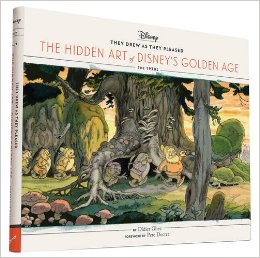
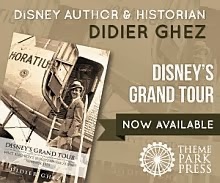

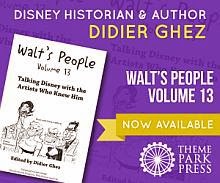



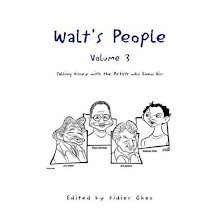
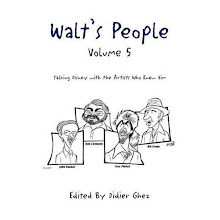
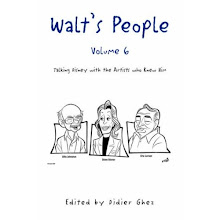






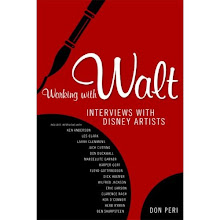

No comments:
Post a Comment